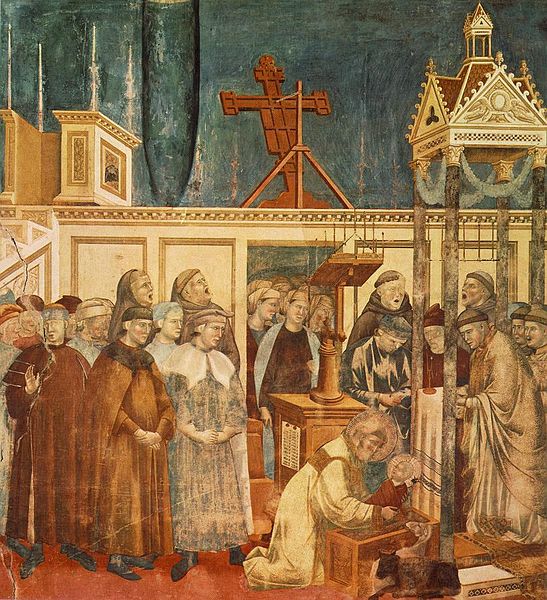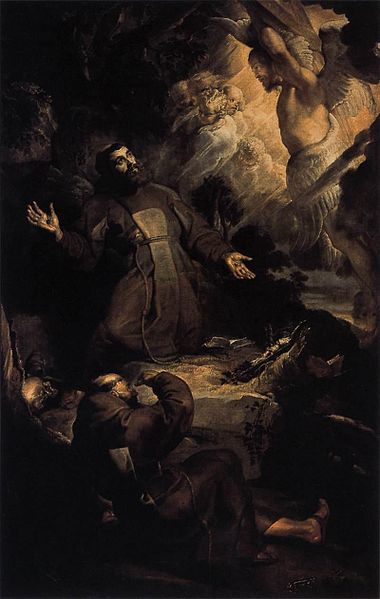
It had become evident that the simple, familiar, and unceremonious ways which had marked the Franciscan movement at its beginning were gradually disappearing, and that the heroic poverty practiced by Francis and his companions at the outset became less easy as the friars with amazing rapidity increased in number. And this Francis could not help seeing on his return. Cardinal Ugolino had already undertaken the task “of reconciling inspirations so unstudied and so free with an order of things they had outgrown.” This remarkable man, who afterwards ascended the papal throne as Gregory IX, was deeply attached to Francis, whom he venerated as a saint and also, some writers tell us, managed as an enthusiast. That Cardinal Ugolino had no small share in bringing Francis’s lofty ideals “within range and compass” seems beyond dispute, and it is not difficult to recognize his hand in the important changes made in the organization of the order in the so-called Chapter of Mats. At this famous assembly, held at Porziuncola at Whitsuntide, 1220 or 1221 (there is seemingly much room for doubt as to the exact date and number of the early chapters), about 5000 friars are said to have been present, besides some 500 applicants for admission to the order. Huts of wattle and mud afforded shelter for this multitude. Francis had purposely made no provision for them, but the charity of the neighboring towns supplied them with food, while knights and nobles waited upon them gladly.
It was on this occasion that Francis, harassed no doubt and disheartened at the tendency betrayed by a large number of the friars to relax the rigors of the rule, according to the promptings of human prudence, and feeling, perhaps unfitted for a place which now called largely for organizing abilities, relinquished his position as general of the order in favor of Peter of Cattaneo. But the latter died in less than a year, being succeeded as vicar-general by the unhappy Brother Elias, who continued in that office until the death of Francis. The saint, meanwhile, during the few years that remained in him, sought to impress on the friars by the silent teaching of personal example of what sort he would fain have them to be. Already, while passing through Bologna on his return from the East, Francis had refused to enter the convent there because he had heard it called the “House of the Friars” and because a studium had been instituted there. He moreover bade all the friars, even those who were ill, quit it at once, and it was only some time after, when Cardinal Ugolino had publicly declared the house to be his own property, that Francis suffered his brethren to re-enter it. Yet strong and definite as the saint’s convictions were, and determinedly as his line was taken, he was never a slave to a theory in regard to the observances of poverty or anything else; about him indeed, there was nothing narrow or fanatical. As for his attitude towards study, Francis desired for his friars only such theological knowledge as was conformable to the mission of the order, which was before all else a mission of example. Hence he regarded the accumulation of books as being at variance with the poverty his friars professed, and he resisted the eager desire for mere book-learning, so prevalent in his time, in so far as it struck at the roots of that simplicity which entered so largely into the essence of his life and ideal and threatened to stifle the spirit of prayer, which he accounted preferable to all the rest.
In 1221, so some writers tell us, Francis drew up a new rule for the Friars Minor. Others regard this so-called Rule of 1221 not as a new rule, but as the first one which Innocent had orally approved; not, indeed, its original form, which we do not possess, but with such additions and modifications as it has suffered during the course of twelve years. However this may be, the composition called by some the Rule of 1221 is very unlike any conventional rule ever made. It was too lengthy and unprecise to become a formal rule, and two years later Francis retired to Fonte Colombo, a hermitage near Rieti, and rewrote the rule in more compendious form. This revised draft he entrusted to Brother Elias, who not long after declared he had lost it through negligence. Francis thereupon returned to the solitude of Fonte Colombo, and recast the rule on the same lines as before, its twenty-three chapters being reduced to twelve and some of its precepts being modified in certain details at the instance of Cardinal Ugolino. In this form the rule was solemnly approved by Honorius III, 29 November, 1223 (Litt. “Solet annuere”). This Second Rule, as it is usually called or Regula Bullata of the Friars Minor, is the one ever since professed throughout the First Order of St. Francis. It is based on the three vows of obedience, poverty, and chastity, special stress however being laid on poverty, which Francis sought to make the special characteristic of his order, and which became the sign to be contradicted. This vow of absolute poverty in the first and second orders and the reconciliation of the religious with the secular state in the Third Order of Penance are the chief novelties introduced by Francis in monastic regulation.
[like url=https://www.facebook.com/ReturnToOrder.org]
It was during Christmastide of this year (1223) that the saint conceived the idea of celebrating the Nativity “in a new manner”, by reproducing in a church at Greccio the praesepio of Bethlehem, and he has thus come to be regarded as having inaugurated the population devotion of the Crib. Christmas appears indeed to have been the favorite feast of Francis, and he wished to persuade the emperor to make a special law that men should then provide well for the birds and the beasts, as well as for the poor, so that all might have occasion to rejoice in the Lord.

Early in August, 1224, Francis retired with three companions to “that rugged rock ‘twixt Tiber and Arno”, as Dante called La Verna, there to keep a forty days fast in preparation for Michaelmas. During this retreat the sufferings of Christ became more than ever the burden of his meditations; into few souls, perhaps, had the full meaning of the Passion so deeply entered. It was on or about the feast of the Exaltation of the Cross (14 September) while praying on the mountainside, that he beheld the marvelous vision of the seraph, as a sequel of which there appeared on his body the visible marks of the five wounds of the Crucified which, says an early writer, had long since been impressed upon his heart. Brother Leo, who was with St. Francis when he received the stigmata, has left us in his note to the saint’s autograph blessing, preserved at Assisi, a clear and simple account of the miracle, which for the rest is better attested than many another historical fact.
The saint’s right side is described as bearing on open wound which looked as if made by a lance, while through his hands and feet were black nails of flesh, the points of which were bent backward. After the reception of the stigmata, Francis suffered increasing pains throughout his frail body, already broken by continual mortification. For, condescending as the saint always was to the weaknesses of others, he was ever so unsparing towards himself that at the last he felt constrained to ask pardon of “Brother Ass”, as he called his body, for having treated it so harshly. Worn out, moreover, as Francis now was by eighteen years of unremitting toil, his strength gave way completely, and at times his eyesight so far failed him that he was almost wholly blind. During an access of anguish, Francis paid a last visit to St. Clare at St. Damian’s, and it was in a little hut of reeds, made for him in the garden there, that the saint composed that “Canticle of the Sun”, in which his poetic genius expands itself so gloriously. This was in September, 1225. Not long afterwards Francis, at the urgent instance of Brother Elias, underwent an unsuccessful operation for the eyes, at Rieti. He seems to have passed the winter 1225-26 at Siena, whither he had been taken for further medical treatment.
What Does Saint Thomas Say About Immigration?
In April, 1226, during an interval of improvement, Francis was moved to Cortona, and it is believed to have been while resting at the hermitage of the Celle there, that the saint dictated his testament, which he describes as a “reminder, a warning, and an exhortation”. In this touching document Francis, writing from the fullness of his heart, urges anew with the simple eloquence, the few, but clearly defined, principles that were to guide his followers, implicit obedience to superiors as holding the place of God, literal observance of the rule “without gloss”, especially as regards poverty, and the duty of manual labor, being solemnly enjoined on all the friars. Meanwhile alarming dropsical symptoms had developed, and it was in a dying condition that Francis set out for Assisi. A roundabout route was taken by the little caravan that escorted him, for it was feared to follow the direct road lest the saucy Perugians should attempt to carry Francis off by force so that he might die in their city, which would thus enter into possession of his coveted relics. It was therefore under a strong guard that Francis, in July, 1226, was finally borne in safety to the bishop’s palace in his native city amid the enthusiastic rejoicings of the entire populace.


